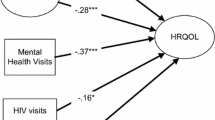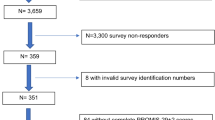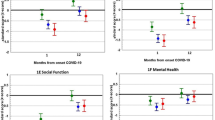Abstract
Purpose
To compare health-related quality of life (HRQoL) between patients receiving care in Veterans Administration (VA) settings (veterans) and non-VA settings (nonveterans), and to explore determinants of HRQoL and change in HRQoL over time in subjects living with HIV/AIDS.
Subjects
One hundred veterans and 350 nonveterans with HIV/AIDS from 2 VA and 2 university-based sites in 3 cities interviewed in 2002 to 2003 and again 12 to 18 months later.
Methods
We assessed health status (functional status and symptom bother), health ratings, and health values (time tradeoff [TTO] and standard gamble [SG] utilities). We also explored bivariate and multivariable associations of HRQoL measures with a number of demographic, clinical, spiritual/religious, and psychosocial characteristics.
Results
Compared with nonveterans, the veteran population was older (47.7 vs 42.0 years) and consisted of a higher proportion of males (97% vs 83%), of participants with a history of injection drug use (23% vs 15%), and of subjects with unstable housing situations (14% vs 6%; P<.05 for all comparisons). On scales ranging from 0 (worst) to 100 (best), veterans reported significantly poorer overall function (mean [SD]; 65.9 [17.2] vs 71.9 [16.8]); lower rating scale scores (67.6 [21.7] vs 73.5 [21.0]), lower TTO values (75.7 [37.4] vs 89.0 [23.2]), and lower SG values (75.0 [35.8] vs 83.2 [28.3]) than nonveterans (P<.05 for all comparisons); however, in multivariable models, veteran status was only a significant determinant of SG and TTO values at baseline. Among other determinants that were associated with multiple HRQoL outcomes in baseline and follow-up multivariable analyses were: symptom bother, overall function, religiosity/spirituality, depressive symptoms, and financial worries.
Conclusions
Veterans reported significantly poorer HRQoL than nonveterans, but when controlling for other factors, veteran status was only a significant determinant of TTO and SG health values at baseline. Correlates of HRQoL such as symptom bother, spirituality/religiosity, and depressive symptoms could be fruitful potential targets for interventions to improve HRQoL in patients with HIV/AIDS.
Similar content being viewed by others
References
Aldeen T, Wells C, Hay P, Davidson F, Lau R Lipodystrophy associated with nevirapine-containing antiretroviral therapies. AIDS. 1999;13:865–7.
Carr A, Miller J, Law M, Cooper DA. A syndrome of lipcatrophy, lactic acidaemia and liver dysfunction associated with HIV nucleoside ana logue therapy: contribution to protease inhibitor-related lipodystrophy syndrome. AIDS. 2000;14:F25–32.
Roudiere L, Viard JP. Osteonecrosis of the hip, lipodystrophy and an tiretroviral treatment. AIDS. 2000;14:2056.
Tsiodras S, Mantzoros C, Hammer S, Samore M. Effects of protease inhibitors on hyperglycemia, hyperlipidemia, and lipodystrophy: a 5-year cohort study. Arch Intern Med. 2000;160:2050–6.
Tsevat J, Solzan JG, Kuntz KM, et al. Health values of patients infected with human immunodeficiency virus. Relationship to mental health and physical functioning. Med Care. 1996;34:44–57.
Miners AH, Sabin CA, Mocroft A, Youle M, Johnson M. Health-related quality of life in individuals infected with HIV in the era of HAART. HIV Clin Trials. 2001;2:484–92.
Hays RD, Cunningham WE, Sherbourne CD, et al. Health-related quality of life in patients with human immunodeficiency virus infection in the United States: results from the HIV Cost and Services Utilization Study. Am J Med. 2000;108:714–22.
Call SA, Klapow JC, Stewart KE et al. Health-related quality of life and virologic outcomes in an HIV clinic. Qual Life Res. 2000;9:977–85.
Bing EG, Hays RD, Jacobson LP, et al. Health-related quality of life among people with HIV disease: results from the Multicenter AIDS Cohort Study. Qual Life Res. 2000;9:55–63.
Coplan PM, Cook JR, Carides GW, et al. Impact of indinavir on the quality of life in patients with advanced HIV infection treated with zidovudine and lamivudine. Clin Infect Dis. 2004;39:426–33.
Mrus JM, Williams PL, Tsevat J, Cohn SE, Wu AW. Gender differences in health-related quality of life in patients with HIV/AIDS. Qual Life Res. 2005;14:479–91.
Wu AW, Hays RD, Kelly S, Malitz F, Bozzette SA. Applications of the Medical Outcomes Study health-related quality of life measures in HIV/AIDS. Qual Life Res. 1997;6:531–54.
Cunningham WE, Shapiro MF, Hays RD, et al. Constitutional symptoms and health-related quality of life in patients with symptomatic HIV disease. Am J Med. 1998;104:129–36.
Justice AC, Chang CH, Rabeneck L, Zackin R. Clinical importance of provider-reported HIV symptoms compared with patient-report. Med Care. 2001;39:397–408.
Lorenz KA, Shapiro MF, Asch SM, Bozzette SA, Hays RD. Associations of symptoms and health-related quality of life: findings from a national study of persons with HIV infection. Ann Intern Med. 2001;134: 854–60.
Tsevat J, Sherman SN, McElwee JA, et al. The will to live among HIV-infected patients. Ann Intern Med. 1999;131:194–8.
Revicki DA, Wu AW, Murray MI. Change in clinical status, health status, and health utility outcomes in HIV-infected patients. Med Care. 1995;33:173–82.
Lenert LA, Feddersen M, Sturley A, Lee D. Adverse effects of medications and trade-offs between length of life and quality of life in human immunodeficiency virus infection. Am J Med. 2002;113:229–32.
U.S. Census Bureau. Current Population Survey March, 1998.
Department of Veterans Affairs, Office of Research and Development, Health Services Research and Development Service (HSR&D). Program Announcement: HIV/AIDS: Investigator-Initiated Priorities, in HIV/AIDS October 16, 1998.
Honiden S, Sundaram V, Nease RF, et al. The effect of diagnosis with HIV infection on health-related quality of life. Qual Life Res. 2006;15: 69–82.
Crothers K, Griffith TA, McGinnis KA, et al. The impact of cigarette smoking on mortality, quality of life, and comorbid illness among HIV-positive veterans. J Gen Intern Med. 2005;20:1142–5.
Kilbourne AM, Justice AC, Rollman BL, et al. Clinical importance of HIV and depressive symptoms among veterans with HIV infection. J Gen Intern Med. 2002;17:512–20.
Smola S, Justice AC, Wagner J, Rabeneck L, Weissman S, Rodriguez-Barradas M. Veterans aging cohort three-site study (VACS 3): overview and description. J Clin Epidemiol. 2001;54:S61-S76.
Murri R, Fantoni M, Del Borgo C, et al. Determinants of health-related quality of life in HIV-infected patients. AIDS Care, 2003;15:581–90.
Jia H, Uphold CR, Wu S, Chen GJ, Duncan PW. Predictors of changes in health-related quality of life among men with HIV infection in the HAART era. AIDS Patient Care STDS. 2005;19:395–405.
Wilson IB, Cleary PD. Linking clinical variables with bealth-related quality of life. A conceptual model of patient outcomes. JAMA. 1995;273:59–65.
Tsevat J. What do utilities measure? Med Care. 2000;38:III 60–4.
Holmes WC, Shea JA. Performance of a new. HIV/AIDS-targeted quality of life (HAT-QoL) instrument in asymptomatic, seropositive individuals. Qual Life Res. 1997;6:561–71.
Holmes WC, Shea JA. A new HIV/AIDS-Targeted Quality of Life (HATQoL) instrument: development, reliability, validity. Med Care. 1998; 36:138–54.
Justice AC, Holmes W, Gifford AL, et al. Development and validation of a self-completed HIV symptom index. J Clin Epidemiol. 2001;54: S77-S90.
Justice AC, Rabeneck L, Hays RD, Wu AW, Bozzette SA. Sensitivity, specificity, reliability, and clinical validity of provider-reported symptoms: a comparison with self-reported symptoms. Outcomes Committee of the AIDS Clinical Trials Group. J Acquir Immune Defic Syndr. 1999;21:126–33.
Torrance GW. Utility approach to measuring health-related quality of life. J Chronic Dis. 1987;40:593–603.
Stalmeier PF, Goldstein MK, Holmes AM, et al. What should be reported in a methods section on utility assessment? Med Decis Making. 2001;21:200–7.
Andresen EM, Malmgren JA, Carter WB, Patrick DL. Screening for depression in well older adults: evaluation of a short form of the CES-D [Center for Epidemiologic Studies Depression Scale). Am J Prev Med. 1994;10:77–84.
Radloff LS The CES-D scale: a self-report depression scale for research in the general population. Appl Psychol Meas. 1977;1:385–401.
Devins GM, Orme CM, Costello CG, Binik YM. Measuring depressive symptoms in illness populations: psychometric properties of the Center for Epidemiologic Studies Depression (CES-D) scale. Psychol Health. 1988;2:139–56.
Bastardo YM, Kimberlin CL. Relationship between quality of life, social support and disease-related factors in HIV-infected persons in Venezuela. AIDS Care. 2000;12:673–84.
Brookings JB, Bolton B. Confirmatory factor analysis of the Interpersonal Support Evaluation List. Am J Commun Psychol. 1988;16: 137–47.
Peterman AH, Fitchett G, Brady MJ, Hernandez L, Cella D. Measuring spiritual well-being in people with cancer: the functional assessment of chronic illness therapy-Spiritual Well-being Scale (FACIT-Sp). Ann Behav Med. 2002;24:49–58.
Brady MJ, Peterman AH, Fitchett G, Mo M, Cella D. A case for including spirituality in quality of life measurement in oncology. Psychooncology. 1999;8:417–28.
Koenig H, Parkerson GR Jr., Meador KG. Religion index for psychiatric research (letter). Am J Psychiatry. 153:885–6.
Pargament KI, Smith B, Koenig HG. Patterns of positive and negative religious coping with major life stressors. J Sci Study Relig. 1998;37:710–24.
Pargament KI, Koenig HG, Perez LM. The many methods of religious coping: development and initial validation of the RCOPE. J Clin Psychol. 2000;56:519–43.
Robinson JP, Shaver PR Measuring Social Psychological Attitudes. Ann Arbor, MI: Institute for Social Research; 1969.
Krause N, Van Tran T. Stress and religious involvement among older blacks. J Gerontol. 1989;44:S4-IS3.
Ellison CG. Religious involvement and self-perception among black Americans. Social Forces. 1993;71:1027–55.
Gray-Little B, Williams VSL, Hancock TD. An item response theory analysis of the Rosenberg Self-Esteem Scale. Person Social Psychol Bull. 1997;23:443–51.
Pearson SD, Goldman L, Orav EJ, et al. Triage decisions for emergency department patients with chest pain: do physicians’ risk attitudes make the difference? J Gen Intern Med. 1995;10:557–64.
revicki DA, Simpson KN, Wu AW, LaVallee RL. Evaluating the quality of life associated with rifabutin prophylaxis for Mycobacterium avtum complex in persons with AIDS: combining Q-TWiST and multiattribute utility techniques. Qual Life Res.. 1995;4:309–18.
Mrus JM, Sherman KE, Leonard AC, Sherman SN, Mandell KL, Tsevat J. Health, values of HIV/hepatitis C coinfected patients: are two viruses worse than one? Med Care. 2006;44:158–66.
Author information
Authors and Affiliations
Corresponding author
Rights and permissions
About this article
Cite this article
Mrus, J.M., Leonard, A.C., Yi, M.S. et al. Health-related quality of life in veterans and nonveterans with HIV/AIDS. J GEN INTERN MED 21 (Suppl 5), S39–S47 (2006). https://doi.org/10.1111/j.1525-1497.2006.00644.x
Issue Date:
DOI: https://doi.org/10.1111/j.1525-1497.2006.00644.x




